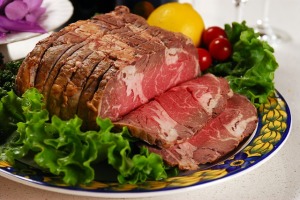Exercise is More Effective on a Protein Rich Diet
Four Month Study
Both groups consumed the same number of calories, but the first group substituted high-quality protein foods, such as meats, dairy, eggs, and nuts, for foods high in carbohydrates, such as breads, rice, cereal, pasta, and potatoes.
“Both diets work because, when you restrict calories, you lose weight. But the people on the higher-protein diet lost more weight. Some people refer to this as the metabolic advantage of a protein-rich diet,” said Layman.
The study included two levels of exercise. “For one group, we recommended that they add walking to their lives. They usually walked two to three times a week, less than 100 minutes of added exercise,” the researcher said.
The other group was required to engage in five 30-minute walking sessions and two 30-minute weightlifting sessions per week. In both groups of dieters, the required exercise program helped spare lean muscle tissue and target fat loss. But, in the protein-rich, high-exercise group, Layman noted a statistically significant effect. That group lost even more weight, and almost 100 percent of the weight loss was fat, Layman said. In the high-carbohydrate, high-exercise group, as much as 25 to 30 percent of the weight lost was muscle.
While this protein-rich diet works for everyone, it seems to be even more effective for people who have high triglyceride levels and carry excess weight in their midsection–a combination of health problems known as Syndrome X.
“The protein-rich diet dramatically lowered triglycerides and had a statistically significant effect on trunk fat, both risk factors associated with heart disease,” he said. “Exercise helped dieters lose an even greater percentage of body fat from the abdominal area.”
Why the Protein Rich Diet Worked so Well
The protein-rich diet works so well because it contains a high level of the amino acid leucine. Leucine, working together with insulin, helps stimulate protein synthesis in muscle. “The diet works because the extra protein reduces muscle loss while the low-carbohydrate component gives you low insulin, allowing you to burn fat,” he said.
“We believe a diet based on the food guide pyramid actually does not provide enough leucine for adults to maintain healthy muscles. The average American diet contains 4 or 5 grams of leucine, but to get the metabolic effects we’re seeing, you need 9 or 10 grams,” he noted.
To achieve that leucine level, the researcher recommended adding dairy, meat, and eggs, all high-quality proteins, to the diet. According to Layman, losing weight doesn’t have to mean relying on supplements to fill in nutritional gaps in your diet. “If you use a high-quality protein approach to your diet, you can actually improve the overall quality of your diet while losing weight,” he said.
Comment by Mark
Many high-protein diets, such as the Atkins plan, have fallen from favour with consumers. Layman’s diet for the study was lower in fat and called for more fruits and vegetables than the Atkins diet.
However, other diets such as Barry Sears Zone Diet and the South Beach Diet are much closer to the target regime the dieters in the study followed.
What is telling though is the fact that the USDA food pyramid has been shown scientifically not to be adequate and that by following the USDA recommended dietary proportions you are actually decreasing the effectiveness of the diet and exercise.
How is that for vindication of the low carb diet?
While the study was carried out using female participants, there are excellent indications that similar results would be obtained for men. Particularly when you realise that most men carry their excess weight around the mid section in the infamous beer belly.
Note too, that the high carb group lost muscle mass while in the high protein group the losses were almost entirely FAT.
Other researchers involved in the study are Ellen Evans, Jamie I. Baum, Jennifer Seyler, Donna J. Erickson, and Richard A. Boileau, all of the University of Illinois. The study was funded by the Illinois Council on Food and Agricultural Research (C-FAR), the National Cattlemen’s Beef Association, the Beef Board, and Kraft Foods.
Tagged with: Exercise • healthy eating • Low Carb
Filed under: Exercise • Low Carb
Like this post? Subscribe to my RSS feed and get loads more!



Leave a Reply
You must be logged in to post a comment.